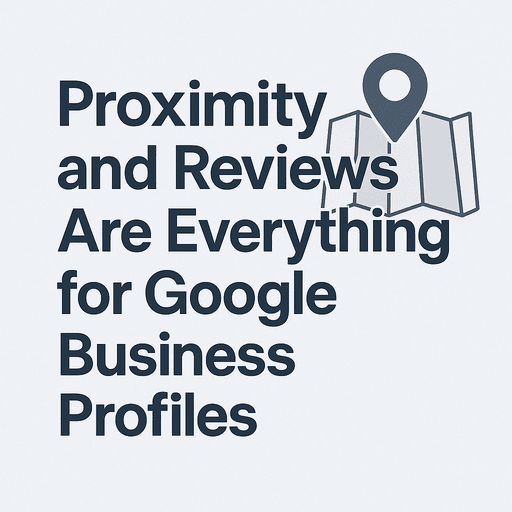Prioritize Proximity and Reviews for Optimizing Google Business Profiles: A Search Atlas Study

Short Answer: According to the 2025 Search Atlas machine-learning study of 7,718 businesses across 18 industries, proximity is the single strongest driver of local Google rankings, while review count and keyword relevance decide who ranks in the top 10.
Introduction
Local search visibility can make or break a business. Whether you’re a neighborhood café or a regional law firm, your placement in Google’s Map Pack determines who calls, visits, and converts. The new Search Atlas Local SEO Ranking Factors by Industry study finally quantifies what most SEOs have long suspected: where you’re located and how customers talk about you in reviews dominate Google Business Profile (GBP) visibility.
Key Takeaways
-
🗺️ Proximity explains over 55% of GBP ranking outcomes across all sectors.
-
⭐ Reviews and review keyword relevance determine who rises within the top 10.
-
🏥 Industry variation matters: Legal and Retail depend on location, while Tech and Professional Services rely on relevance and reviews.
-
💬 Review language influences visibility: Google parses NLP signals from customer text to match queries.
-
⚙️ Domain authority, category, and completeness play smaller but supportive roles.
How the Study Worked
Search Atlas analyzed over 7,700 businesses spanning 676 categories and 18 industries, from real estate to healthcare to automotive. Using XGBoost regression, a high-accuracy machine-learning model, the team measured how dozens of variables like distance, review data, content relevance, authority, and GBP completeness explained rank positions in Google Maps.
The model explained 92–93% of ranking variance, making it one of the most reliable quantitative analyses in local SEO history.
Global Findings: The Two Giants of Local Search
1. Proximity (55.2% influence across all positions)
Distance to the search centroid remains the #1 predictor of visibility. If your address isn’t near the searcher’s location, your listing likely won’t appear regardless of backlinks or website content.
2. Reviews Take Over in the Top 10
Among top-ranking profiles, proximity’s weight drops to 36.2%, while
-
Review count = 26%
-
Review keyword relevance = 22.8%
That means getting found depends on distance, but getting chosen depends on reviews, especially ones using service-specific language such as “best pediatric dentist in El Cajon” or “oil change near Savannah”.
Other secondary factors like domain authority (≈6%), rating quality, and GBP completeness play modest roles but cannot offset poor proximity or weak review signals.
Sector-Specific Insights
Automotive: Ratings Rule Once You’re Close
Across all positions, distance dominates (72%), but among the top 10, rating quality (49%) becomes the single biggest differentiator. Once you’re within range, sentiment matters more than miles.
Construction: Reviews Outweigh Distance
Here, review volume = 45% and proximity = 41% across all positions, but in the top 10, review volume jumps to 53% and keyword relevance = 22%. Contractors win with review quantity and descriptive feedback.
Legal Services: Location, Location, Location
Law firms remain the most proximity-dependent industry. Distance explains about 67–69% of ranking variance, overshadowing reviews or authority.
Healthcare: Reviews > Distance (Almost)
In health, reviews = 33%, review relevance = 25%, and proximity = 23%. Patients trust reputation and service-specific feedback even slightly more than convenience.
Technology & Creative: Relevance Beats Geography
This is the only vertical where semantic relevance (GBP keywords ≈ 27%) and reviews (37%) outrank proximity (16%). For agencies and SaaS firms, content alignment and credibility outweigh physical distance.
Why Proximity and Reviews Dominate
Proximity sets the baseline for visibility. If Google’s centroid model can’t “see” you near the searcher, your profile is filtered out before relevance is even assessed.
Reviews build trust and context. NLP systems in Google’s local algorithm parse review text for topical relevance, matching entities and intent phrases to the query.
Together, they create ranking momentum. Once your business is within visible radius and praised in detailed language, your GBP gains a compounding trust signal over time.
What Local Businesses Should Do
1. Map Your True Centroid
Use tools like Search Atlas GBP Galactic to visualize your map-grid coverage. If you’re too far from core demand, open secondary verified locations or service-area listings.
2. Optimize for “Review Relevance”
Coach customers to mention specific services and locations in reviews. Example prompt:
“We’d love to hear what service you used and which area you’re in. It helps local customers find us.”
3. Enrich GBP Content with Semantic Clarity
In your business name, description, and services fields, weave in high-intent entities, not spammy keywords, but natural language Google can associate with your category.
4. Track Grid-Based Visibility
Monitor not just ranking averages but spatial variance — where you appear in different zip codes. Search Atlas found grid-level differences of up to 80% in some sectors.
5. Sector-Match Your Strategy
-
Law, Retail, Personal Care: Focus on proximity accuracy.
-
Construction, Automotive: Prioritize ratings and detailed reviews.
-
Tech, Professional Services: Optimize semantics and domain authority.
Final Thoughts: You Can’t Outsmart Distance But You Can Outshine Competitors
The Search Atlas findings make one truth undeniable: you can’t out-SEO distance, but you can out-optimize your reputation. Businesses that pair precise location data with authentic, keyword-rich customer reviews will dominate the evolving Map Pack landscape.
If you need help improving your Google Business Profile visibility, building a review strategy, or writing GBP-optimized content for your industry, contact me for professional SEO support. I’ll help you translate these ranking factors into real local results.

0 Comments Add a Comment?